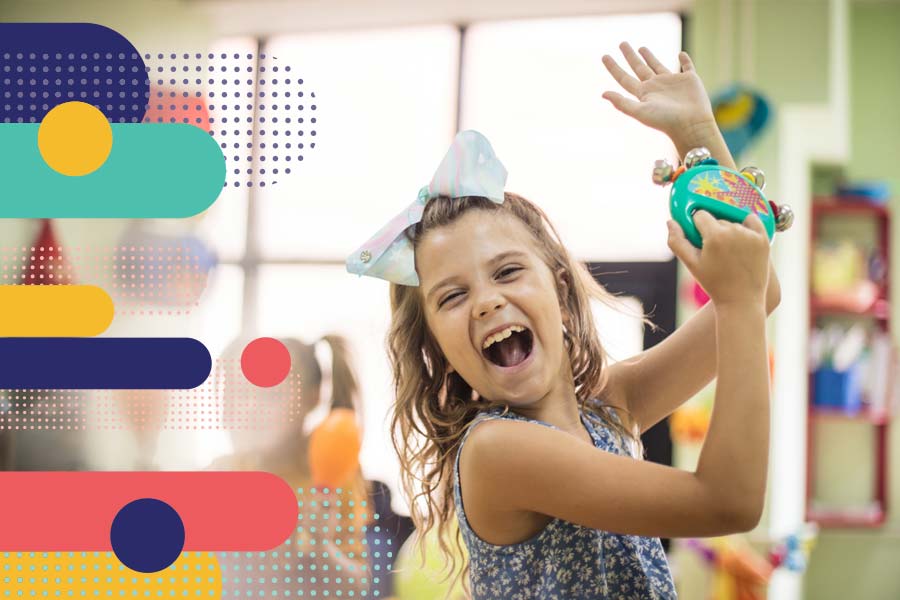TeacherVision Advisory Board Member Jessica shares her tips for integrating music into language arts, math, science, and social studies lessons and activities.

Integrating music into the core subjects can be a little overwhelming, especially if you’re not musical yourself. If you're asked to add music instruction to your core lessons, use these tips to make it an enjoyable process for your students and a painless one for yourself!
Language Arts
Rhyming Books
Try reading rhyming books like a rap, then discuss how the lines have the same number of beats, just like a poem does. Have the child track the story with their finger and point out the rhyming words.
Then, after they’ve found the rhyming words, tell them they’re going to pat their legs every time they hear a word that rhymes. After that, your students can walk around the room to the steady beat while saying the rhyming words with you.
Movement Books
Read books about literally anything. Have the children act out with creative movement to the words they hear read. It is so fun to see how expressive they can get. Examples are dinosaurs, cars, superheroes, ballerinas, or any other book with which they can use their imaginations.
Use any book that includes lots of action words. Some of the best action words are jump, dance, wiggle, and skip.
Books About Composers
Stop to talk about the unknown vocabulary from the time the composers lived and children will learn new words. Reading books about the composers will help develop new vocabulary since there will be lots of new words from those time periods.
Musical Scores
If the child is learning to play an instrument, they will begin reading the notes on the staff, otherwise known as a musical score. Children will form a connection between reading and music when they read the notes on a score.
In beginning piano music, not only are they reading the notes, they are also reading the words to the song. Just like when they read a book, they are learning to read the music from top to bottom and from left to right. So many things are going on in their brains at once and music is also helping them to learn to read better.
Story Books
Show children the pictures in the book you are reading. For example… if it’s about a jazz composer, they will form connections with what you are reading about that performer. There are so many great books about musical genre, time periods, and different artists and composers.
Math
Math Facts
For some students, learning addition, subtraction, multiplication, or division facts is difficult. Saying math facts like a rap is repetitive and helps children retain what they are learning. When spoken like a rap, it’s way more fun than just spouting out answers one at a time. For example, 1×2=. . 2, 2×4=. . 8, 3×6=. . 18 and so on. So, the kids would say the 1×2= part like | | | ||, and the . . part is two beats of silence, and the answer 2 would be said like |. The kids would continue on this pattern seeing if they could go all the way through all of the math facts that they are learning for that day.
Fractions
In the beginning (and sometimes the middle) of a musical piece, there is a time signature that looks like 3/4. The top number tells musicians that there will be 3 beats in a measure and the bottom number means the quarter note will get the beat. When kids learn fractions in a math lesson, they will recognize how each number has a different purpose.
Addition and Subtraction
Along with working on memorizing math facts, music will help kids with addition and subtraction. Each note in music gets a different number of beats and can be used in simple math problems.
For example, a quarter note (1 beat) + a half note (2 beats) = a dotted half note (3 beats). This will help children not only with math facts, but also remembering how many beats the notes in music get. So, not only is music helping in math, math and the other subjects can help in learning music, as well.
Patterns
In math, students learn about patterns. They may learn about shape patterns like "triangle > triangle > square > circle", etc. To practice math patterns in music, children can learn a pattern like "rest > quarter note > quarter note > rest > rest", etc. Students will begin to see how patterns not only happen in math and music, but with any subject or in the world around them.
Number Order
Children practice arranging numbers from lowest to highest and highest to lowest. To practice number order in music, students can arrange the notes from lowest sounding to highest sounding and highest sounding to lowest sounding.
Another way to arrange things from lowest to highest or highest to lowest is by arranging instruments from big to small and small to big. When students do this, without even knowing it, they are arranging the lowest sounding instruments to the highest sounding instruments since the bigger the instrument the lower the sound.
Science
Science and Sound
One of my favorite activities for learning about sound is the cup activity. Fill up 8-10 cups with different amounts of water, like 1/4, 1/3, and 1/2, and experiment with how each cup sounds while hitting it with a spoon.
Students will quickly realize that the cups with less water will sound lower than the cups with more water in them. This can turn into a music lesson by comparing how instruments sound lower or higher depending on how much air is in them and their size.
Frequency and Music
Frequency is definitely a part of music and science. In science, frequency is used in AC alternating current, radio waves, sound waves, and electrical signals in computers. In music, frequency can be used to describe the different notes on a piano, since they have different Hz and therefore sound different.
Finding the similarities between frequency in music and science will be fun for students to experience. Mention to your students that the next time they hear music coming out of the radio, they are experiencing frequency.
Sing About Science
Students love to write and perform their own songs. While studying a unit in science, like astronomy for example, kids can write a song about the planets, stars, or the galaxy. When singing about concepts that are learned, the facts are retained easier and help students remember what was taught. Remind kids that when they sing about science, they are not only learning about science lessons, but their voices are using sound waves too.
Make a Thunderstorm
Kids love to play instruments, and what better way to experiment with sound, silences, and frequency than by creating a thunderstorm. You could talk about how thunderstorms start with little sprinkles, turn into rain, then thunder and lightning, wind, etc.
After talking about how a thunderstorm starts and ends, pick out instruments that would work for each sound. My favorites are shakers, drums, rhythm sticks, a rain stick, or anything else you and your students can come up with.
Go On a Nature Walk
Sound is a part of music and science, and just like our voices while singing, everything in nature makes high and low pitches as well. When you’re outside, you will hear cars, trucks, animals, kids playing, insects, construction workers, and so much more. Without realizing it, your students are getting some outside time, but are also experiencing sounds all around them.
Social Studies
Music from Around the World
One of my favorite things to teach is music from around the world. A lot of times kids haven’t learned music from other cultures and love learning the songs, dances, stories, and instruments that they may not be familiar with.
A great way to connect the music the kids are learning to where it originates from is by having the student’s find the country on the map and making that country the “country of the month." Great instruments to teach about are the djembe, Native American flute, and the steel drum.
Learning the 50 States
A great song to teach about the 50 states is 50 Nifty United States. I like this song because not only does it teach about the 50 states and colonies, but has a fun rhythm and talks about how each state is important. There are so many great states songs that have been written, but this one is so good and I promise will get stuck in your student’s heads.
Name Those Presidents
While learning about the Presidents, a good way to remember the names of them and their order is by creating a rap. Print out a list of the Presidents and try saying their names with a steady beat. To make it even more fun, try tapping a drum beat or making a rhythm while speaking.
Songs About History
There are so many great songs that teach about history or tie in great with a history unit. Student’s can learn songs about wars, important people, about our country, and about the world. I did a whole program based around Martin Luther King Jr. where student’s sang and recited poetry all about this amazing leader. When the unit was done in music, students were more aware of who he was, about his life, and by memorizing the songs, they will be able to retain this information for years to come.
Integrating music into the core subjects is not as overwhelming as you might think it is. Even if you’re not musical, simply just start somewhere. Once you bring a little bit of music into your classroom, you’ll notice how easy and fun it is.
What are your favorite ways to integrate music in the classroom? Share with us on Instagram, Facebook, Twitter, and Pinterest.
Jessica Peresta is passionate about providing other music teachers, especially those right out of college or new to teaching elementary music, with the music education resources, lesson plans, teacher training, and community you've been looking for. She believes your domestic life outside of school should be spent soaking up time with family and friends and your music teacher life while at school should not leave you feeling defeated, but should be a joyful, exciting, and rewarding experience. To find out more about Jessica and her passion, head to The Domestic Musician.










